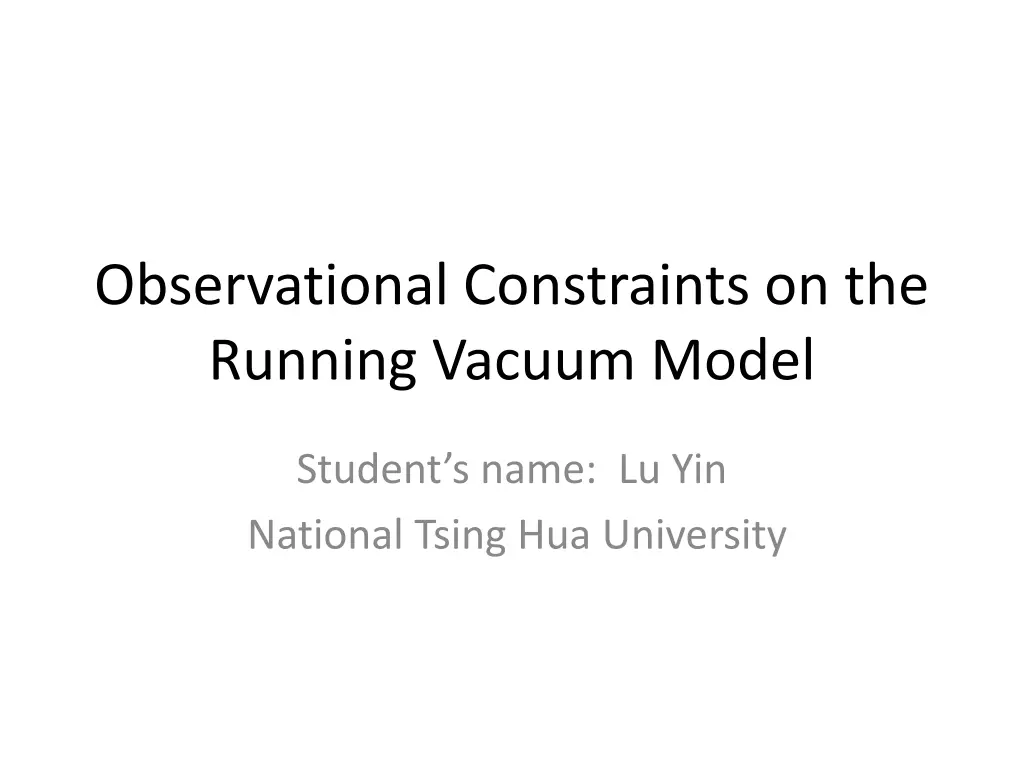
Constraints on Running Vacuum Model
"Explore observational constraints on the Running Vacuum Model (RVM) with a focus on its introduction, Einstein equations, FLRW metric considerations, dark energy coupling with matter and radiation, and metric perturbations. Understand the implications of dark energy and its interactions in the context of cosmology."
Uploaded on | 0 Views
Download Presentation

Please find below an Image/Link to download the presentation.
The content on the website is provided AS IS for your information and personal use only. It may not be sold, licensed, or shared on other websites without obtaining consent from the author. If you encounter any issues during the download, it is possible that the publisher has removed the file from their server.
You are allowed to download the files provided on this website for personal or commercial use, subject to the condition that they are used lawfully. All files are the property of their respective owners.
The content on the website is provided AS IS for your information and personal use only. It may not be sold, licensed, or shared on other websites without obtaining consent from the author.
E N D
Presentation Transcript
Observational Constraints on the Running Vacuum Model Student s name: Lu Yin National Tsing Hua University
Outline Introduce the running vacuum model(RVM) Observational constraints on RVM Summary
Introduce the running vacuum model The Einstein equation is given by g R 2 1 8 = G T + = GT 8 M R g R g set , is the Ricci scalar and is the energy-momentum tensor of matter and radiation is the time-dependent cosmological constant R = M = (H )
Considering the FLRW metric )[ ( ds = + 2 2 2 i j d dx dx ] ij We obtain the Friedmann equations 2 2 + = M H ( ) 3 2 H = + + + ( 3 P 3 P ) M M 6 H = where , is the conformal time and the equation of state(EoS) given by P d /( d ) = + = + = P P P P M m r M m r r 1 = = r , m , 0 , , 1 r , m , 3 r , m ,
We consider to be a function of the Hubble parameter 3 = H 0 + 2 0 + where and are two free parameters, From the conservation equation we have 3 + tot 0 = TM ( T ) 0 + tot = H ( 1 ) 0
Resulting in that dark energy unavoidably couples to matter and radiation , given by + + = 3 H ( 1 ) Q m r , m r , m r , m r , Q is the decay rate of the dark energy taken to be ( Q , r m = - 1 = m, r + P ) = = + m r , m r , 3 H ( 1 ) m r , m r , m r , M ( 3 + ) 1 ( m 0 , ) r m ,r Then we get where and is the energy density of matter or radiation at z = ( 0 ,r m ) 0
The metric perturbation is given by = + + 2 2 2 i j d s ( )[ d ( h ) dx dx ] ij ij 1 = + ) 3 i k x h d ke [ k k i h j ( k , ) ( 6 k k i ( k , )] ij j ij 3 i,j=1,2,3 h and are two scalar perturbation in the synchronous gauge the matter and radiation density perturbation P Q h 2 = + + ) m r , m r , ( 1 )( ) 3 H ( m r , m r , m r , m r , m r , m r , m r , m r , 2 P 1 Q k m = ) + m r , + m r , m r , H ( 1 3 r , m r , m r , m r , m r , 2 m r , m r , = i i m where and r m r m , , ik m r , r , m r ,
Observational constraints on RVM We use the CosmoMC program to perform the global fitting for the RVM Dataset: CMB : Planck 2015 (TT, TE, EE, lowTEB, low-l polarization and lensing from SMICA) BAO : Baryon acoustic oscillation data from BOSS Weak lensing ( ) z H 8 f data and data
= + 2 Fitting results for the RVM with 3 H 0 ( ) z f f parameter RVM RVM+ RVM+ RVM+ + H H 8 8 ( ) z Model parameter ( ) 10 + 64 . 0 03 . 1 + + 53 . 0 10 . 1 + 33 . 1 73 . 0 . 0 77 . 0 . 0 27 . 1 36 . 1 37 . 1 - - - 95 - 97 (68% C.L.) (68% C.L.) (68% C.L.) (68% C.L.) 4 CDM density ( ) 117 . 0 001 . 0 117 . 0 001 . 0 117 . 0 001 . 0 118 . 0 002 . 0 2 ch 2 B 13490.4 13509.8 13511.4 13531.2 est fit 2 ~-1.1
Summary The running vacuum model scenario is suitable to describe the last-time accelerating universe at the background level. By performing the global fit from the observational data , we have obtained that < , implying that the current data lll prefers RVM. 2 RVM 2 CDM Thank you
